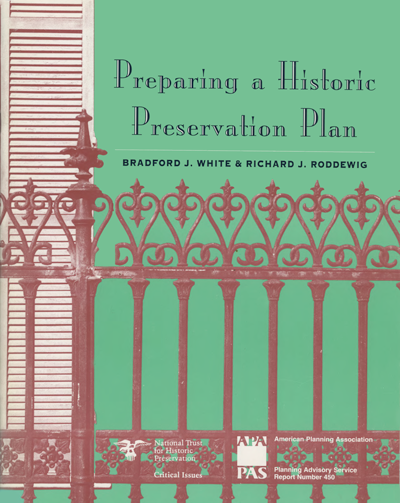Preparing a Historic Preservation Plan
PAS Report 450
By Bradford White, Richard Roddewig

Not a member but want to buy a copy? You'll need to create a free My APA account to purchase.
Create account
The surge in local interest in historic preservation laws has been accompanied by a new wave of planning for the preservation and protection of historic resources.
This report examines the 10 essential elements of a good preservation plan. The authors explain the legal justification for historic preservation and the pitfalls that one can encounter when drafting a plan. Case studies show how various communities have modified these elements to fit individual circumstances and needs.
A look at Atlanta, for example, illustrates how that city was able to build a preservation planning consensus among preservationists and developers.
The appendices include a summary of growth management laws in 11 states that shows how these laws address important historic preservation issues.
Product Details
Table of Contents
1. Why preservation planning?
Purposes of preservation planning • Types of preservation planning • What is a preservation plan?
2. Elements of a good preservation plan
Statement of goals • Definition of historic character • Summary of past preservation efforts: Preservation context • Historic resources survey • Explanation of the legal basis for historic preservation • Coordinating preservation with zoning, land use, and growth management • Defining public sector responsibilities • Incentives for historic preservation • The relationship between preservation and education • An agenda for future action
3. Preparing and implementing a historic preservation plan
Kane County, Illinois: The evolution of a preservation program • San Francisco: The importance of a survey and evaluation system • Building a preservation planning consensus: Baltimore and Atlanta • Iowa City, Iowa: A comprehensive process • Preservation and zoning: Roanoke, Denver, and Elsah • Lawrence, Kansas: Downtown planning to direct development • Implementing the historic preservation plan • Conclusion
Notes
Appendices
A. Growth management laws, comprehensive planning, and historic preservation planning • B. The Secretary of the Interior's standards for preservation planning, identification, evaluation, and registration • C. Boston Landmarks Commission system for evaluating significance • D. Iowa Cioty, Iowa: Mission and summary of goals • E. Kane County, Illinois: Goals and objectives • F. Providence, Rhode Island: Action strategy for preservation • G. Methodology used to rank buildings in San Francisco's downtown survey


